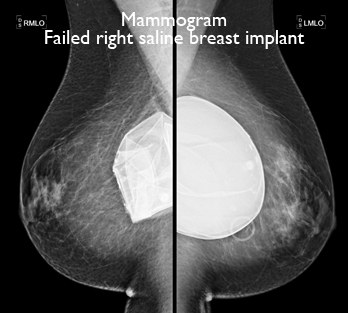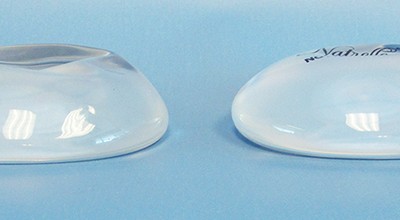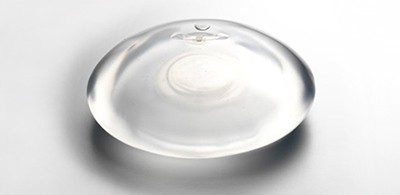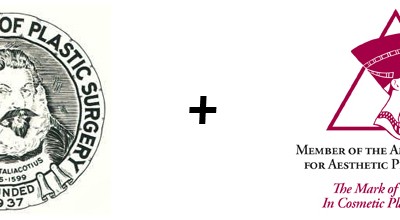
Breast Implant Failure
Breast implants are not considered permanent medical devices. The estimated failure rate is about 1+% per year. The following analogy is a simple way to envision this. If you had a group of 50 women, that would be 100 breasts, and about one implant would fail per year. This is merely an estimated failure rate. Because implants are not considered permanent devices, it is anticipated that the real failure rate will increase as the implant ages. All women undergoing breast augmentation surgery should understand that implants are not considered permanent devices, and they should anticipate having to replace their implants at some point in the future.
Saline Breast Implant Failure
Saline implants can leak through a hole in the implant shell, or through the valve (used to fill the implant) if there is delamination of the valve or tissue in-growth into the valve. The rate of failure will depend upon the size of the hole in the shell, or the type of problem occurring at the valve. Saline may leak through a hole in the shell faster than it will through a compromised valve. For the purposes of discussion and comparison, consider the saline breast implant as being similar to a water balloon. The saline will leak through the hole in the implant shell. The saline that leaks from the implant will be absorbed by the body, and the volume beneath the breast therefore decreases. The implant, and subsequently the breast, will shrink in size as the leaking saline is absorbed. Usually women will report that they have noticed a decrease in their breast size over a time period of one day to several days. A failed saline breast implant is easily recognized by standing in front of a mirror to observe the deflated-looking breast.
Current Saline Implant Failure Rates
[discussion of failure data to come]
Silicone Gel Implant Failure
Silicone gel implant failure differs significantly from that of a saline failure. The amount of gel leakage will depend upon the size of the hole, and the duration of the failure. Gel that leaks from the implant, will be located outside the implant shell, but within the capsule surrounding the breast implant. [The capsule therefore serves a protective function, and (as long as the capsule remains intact) prevents the gel from migrating into other tissue planes.] The leaking silicone gel is not reabsorbed by the body (like saline is). The volume of the breast therefore remains the same, and the breast does not decrease in size. Since the breast does not decrease in size, the failure can go unrecognized by the patient and by the surgeon. The term “silent failure” or “silent rupture” refers to a silicone gel implant failure in comparison to a saline implant failure because it is not easily recognized.
Silicone gel implant failure requires a bit more work on the part of the surgeon. The silicone gel implant is removed, and then any silicone gel that has leaked from the implant must also be removed from inside the capsule. The more cohesive the silicone gel, the less gel that leaks from the implant. Today’s moderately cohesive round gel implants contain silicone gel that is significantly more cohesive then their earlier counterparts. As a result, failure of a modern day round gel implant is not associated with nearly as much gel leakage as would have been seen years ago. And the highly cohesive anatomic gel implants (Natrelle 410, Mentor CPG) demonstrate essentially no gel leakage outside the implant shell.
Current Silicone Gel Implant Failure Rates
In Allergan’s Core Study, implant failure was assessed two ways: one group of women were assessed for failure by screening MRI (the MRI cohort), and the remaining women were not assessed by MRI (the non-MRI cohort). The women in the MRI cohort were assessed for silent implant failure by screening breast MRIs and years 1, 3, 5, 7, and 9. Of the 455 primary augmentation patients enrolled in the Allergan Core Study, 158 (35%) of those women were also enrolled in the MRI cohort. At 7 years, the implant failure rate was 8.6% in this MRI group. In June 2011, The FDA published an update on the safety of silicone gel breast implants. The cumulative incidence of failure in the MRI group at 10 years was 10.1% (7.4 to 13.7%).
[more to come]
MRI Screening of Silicone Gel-Filled Breast Implants
Understanding that a silicone gel breast implant failure is more difficult to recognize than a saline breast implant failure, the FDA recommends that women with silicone gel breast implants have a breast MRI three years following surgery, and then every two years after that. This is meant to be a screening breast MRI to assess the gel implant for failure. This MRI is not mandatory, and is performed at the discretion of the patient. If a woman chooses to have an MRI of the breast, she will have to pay for each MRI study.
(more discussion to come).
Current Implant Failure Rates
(discussion of failure data to come)
Generalized Approach Toward Implant Replacement
Some women will ask about a more proactive approach to implant replacement. There is a common belief that breast implants should be replaced every 10 years. Different surgeons will have differing opinions and recommendations regarding implant replacement, and that approach may vary for saline and silicone breast implants.
For saline implants it is easy to recommend a “wait and see” approach. If a woman is not having problems with her breast implants, and she is happy with her size and shape, then there is no reason to re-operate merely for the purpose of implant replacement. When the saline implant eventually does fail, the implant can be easily removed, replaced, and the opposite breast addressed at the same time as necessary.
Diverging opinions are more likely to exist regarding replacement for silicone gel breast implants. Some (a fewer number of) surgeons may take a more preemptive approach toward silicone gel implant replacement. An example of such an approach would be to recommend replacing gel breast implants every 10 years to avoid having to deal with a failed (leaking) gel implant. The benefit of this approach is that the breast implants are being removed prior to any failure, and the operating surgeon does not have to address the presence of silicone gel inside the breast capsule. But the downside is more frequent operations with significantly more cost for operating expenses and implants (patients are purchasing the replacement implants), and well as more frequent exposure to the potential risks and complications associated with re-operation
Many more surgeons are likely to recommend replacing a silicone gel breast implant once the failure has been identified. The benefit of this approach is that a woman is getting the maximum life out of her implants, the replacement implant is provided by the manufacturer, and the patient is being subjected less frequently to the potential risks and complications associated with re-operation. The down side is that there is likely some silicone gel (even if a small amount) that has leaked into the capsule and requires removal.
It is important that you discuss approaches to implant replacement with your surgeon. The best approach is to consider each patient individually, taking into account each woman’s concerns and preferences when making decisions regarding gel implant replacement.
More to come
NEXT TOPIC: Capsular Contracture
What is the Gel-to-Shell Fill Volume Ratio?
Each round silicone gel-filled breast implant is comprised of a silicone elastomer shell which contains the silicone gel filling. Silicone gel breast implants are filled by the manufacturer with a moderately cohesive (responsive) silicone gel. If you look carefully at...
How Firm is a Saline Breast Implant?
During the consultation today, a patient asked me, "Aren't saline implants harder?" Well, it actually depends. Let me start by saying that if you have ever held a saline implant and a silicone gel implant side-by-side, you know that they feel completely different, and...
Why is a board certified plastic surgeon important for my breast augmentation?
I recently saw a woman in consultation for a failed saline breast implant. She had her breast augmentation performed seven years earlier by a surgeon who advertises like a plastic surgeon, but is not board certified in plastic surgery. And as far as I am aware, has...




